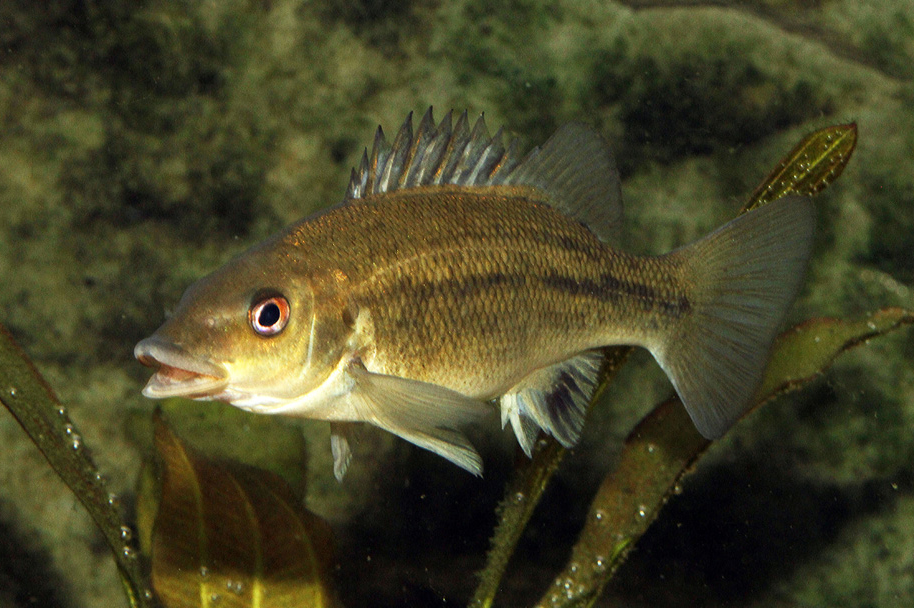Longnose Grunter, Syncomistes trigonicus Vari 1978

A Longnose Grunter, Syncomistes trigonicus, from the Drysdale River, The Kimberley, Western Australia - photographed in an aquarium. Source: Dave Wilson / Aquagreen. License: All rights reserved
Longnose Grunter, Syncomistes trigonicus Vari 1978
More Info
|
Distribution |
Known only from northern WA from the Prince Regent River (15º50´S) to King Edward River (126º11´E), WA; a tropical species inhabiting moderate to swift-flowing freshwater streams, in clear or slightly murky waters over rock or sand bottoms. |
|
Features |
Dorsal fin XI-XII, 12-13; Anal fin III, 8-9; Pectoral fin 14-15; Pelvic fin I, 5; Lateral line 46-51; Trv Scales 7-8/1/15-18; Gill rakers 7-8+1+15-16; Verteebrae 11+14. Body slender, depth 3.2-3.5 in SL, ovate, only slightly compressed; dorsal profile much more pronounced than ventral in juveniles, only slightly more in adults, slightly concave behind premaxillaries, convex from that point to interorbital region, then straight to dorsal origin. Head length 3.3-3.45 in SL. Snout distinctly pointed; length 2.0-2.6 in HL. Nostrils separated by a distance equal to diameter of posterior nostril; both nostrils with free cutaneous edges, anterior tube-like. Eye width 4.0-5.0 in HL, getting relatively smaller with increasing SL. Interorbital region smooth. Upper jaw slightly more fleshy and longer than lower, length 2.8-3.5 in HL, becoming relatively larger with increasing age; gape of mouth horizontal; maxillary reaching to vertical drawn between nostrils; lower jaw triangular when viewed from ventral aspect, reduced, flattened, with teeth pointing laterally; upper and lower jaws with an equal number of teeth in outer row of jaw; each jaw with an outer row of highly depressible flattened teeth followed by a distinct narrow band of smaller teeth; lower jaw with a prominent medial dorsally oriented bump at symphysis, bump corresponding in position to depression between premaxillaries; both bump and depression edentulous; no teeth on vomer or palatines. Lacrimal with 3-4 coarse serrations. Preoperculum serrate; serrations strongest on vertical edge. Lower opercular spine longer and stronger; not extending beyond edge of opercular lobe. Cleithrum exposed; serrate along posterior edge; scales on side. Supracleithrum exposed. Posttemporal exposed; serrate along posterior edge. Scales finely ctenoid; lateral line continuous, smoothly curved; caudal scales 3-6; predorsal scales to occiput 14-17; cheek scales in 3-4 rows; two irregular rows of scales in sheath at base of dorsal fin in some specimens, two complete rows in others, sheath extending to fifth or sixth dorsal ray; sheath at base of anal consisting of three rows of scales, sheath extending to second to fourth anal rays;. Dorsal fin continuous, base 1.95-2.05 in SL; spinous portion arched; first spine short; fourth longest, 2.3-3.0 in HL, but shorter than longest dorsal rays, spines following longest dorsal spines decreasing in length to penultimate, which is shorter than last; longest dorsal ray 2.0-2.6 in HL; soft dorsal rounded. Second anal spine longest, 2.1-2.9 in HL, three times length of first, shorter than longest anal rays; longest anal ray 1.8-2.1 in HL; soft anal angular. Ventral fins inserting posterior to vertical through origin of dorsal fin; fins pointed; first ray longest; reaching one-half distance to anus. Pectoral fins asymmetrically pointed; fifth ray longest. Caudal fin slightly emarginate. |
|
Size |
To around 17cm SL. |
|
Colour |
Adults uniformly dark brown above lateral midline of body; scales with a posterior band of pigmentation, increasing in intensity and extent dorsally, most intense under dorsal sheath. Posterior and ventral borders of eye surrounded by pigment band. Operculum very dark ventral to opercular spine. Membranes of dorsal and caudal fins dusky; anal fin with dark proximal blotch; other fins clear. Very large fish uniformly dark, slightly paler ventrally; all fins, especially median fins, dusky. Juveniles with three stripes on sides; body darker dorsally, almost white along midventral line. Anal fin with basal blotch extending posteriorly on anterior rays. Caudal and dorsal membranes dusky. All other fins clear. |
|
Feeding |
Herbivore, feeding primarily on filamentous algae, which is scraped from hard surfaces using the specially modified teeth. |
|
Biology |
Little is known of the reproductive biology of this species but it is likely to deposit demersal eggs onto the substrate. |
|
Remarks |
Often forms shoals mixed with S. rastellus. |
|
Etymology |
Syncomistes is from the Greek noun meaning 'gatherer', in reference to the algae-cropping habits of members of this genus. The specific name trigonicus, is from the Latin for 'triangle', in reference to the triangular shape of the lower jaw when viewed from below. |
|
Species Citation |
Syncomistes trigonicus Vari, 1978, Bull. Amer. Mus. Nat. Hist. 159(5): 317. Type locality: Wyulda Creek, Roe River, WA. |
|
Author |
Gomon, M.F. & Bray, D.J. 2020 |
Longnose Grunter, Syncomistes trigonicus Vari 1978
References
Allen, G.R. 1982. Inland Fishes of Western Australia. Perth : Western Australian Museum 86 pp. 6 figs 20 pls.
Allen, G.R., Midgley, S.H. & Allen, M. 2002. Field guide to the freshwater fishes of Australia. Perth : Western Australian Museum 394 pp.
Leggett, R. & Merrick, J.R. 1987. Australian Native Fishes for Aquariums. Artarmon : J.R. Merrick Publications 241 pp. 142 figs.
Merrick, J.R. & Schmida, G.E. 1984. Australian Freshwater Fishes Biology and Management. Sydney : J.R. Merrick 409 pp.
Shelley, J.J., Delaval, A. & Le Feuvre, M.C. 2017. A revision of the grunter genus Syncomistes (Teleostei, Terapontidae, Syncomistes) with descriptions of seven new species from the Kimberley region, northwestern Australia. Zootaxa 4367(1): 1-103 DOI: http://dx.doi.org/10.11646/zootaxa.4367.1.1 Abstract
Shelley, J.J., Gomon, M.F. & Le Feuvre, M.C. 2018. Family Terapontidae. pp. 118-158 in Shelley, J.J., Morgan, D.L., Hammer, M.P., Le Feuvre, M.C., Moore, G.I., Gomon, M.F., Allen, M.G. & Saunders, T. (eds) A field guide to the freshwater fishes of the Kimberley. Murdoch University, Murdoch, Western Australia, 262 pp.
Vari, R.P. 1978. The terapon perches (Percoidei, Teraponidae). A cladistic analysis and taxonomic revision. Bulletin of the American Museum of Natural History 159 (5): 175-340.





